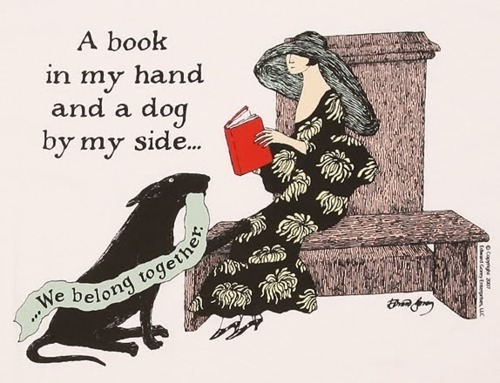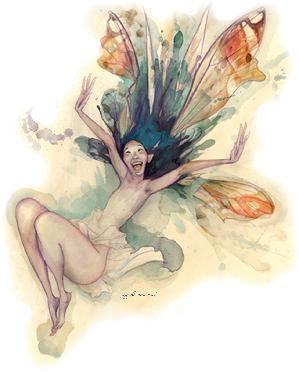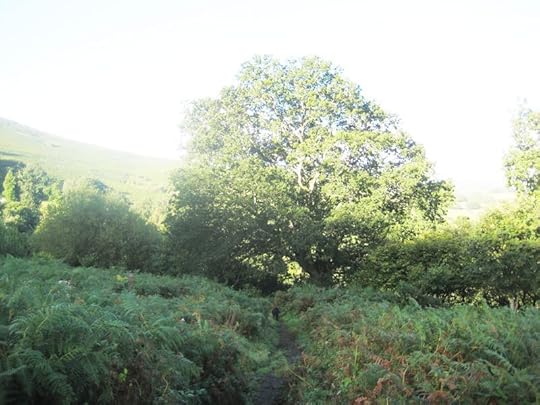Terri Windling's Blog, page 210
September 27, 2012
Publication Day
Roll up! Roll up! Tilly has opened her bookstall to sell copies of Rex and Howard's newly-published graphic novel, John Barleycorn Must Die: a metaphysical mystery about a magician-sleuth in modern day London. (The name of the novel, of course, comes from an old British folksong and Robert Burns poem.) Please join me in congratulating the two knuckleheads distinguished artists in the studio next door to mine, on this, the book's Publication Day. It's such a pleasure to hold the finished volume in my hands, and to be able to share it with others.
If you'd like to sample the first three chapters of the comic, or order a copy, you can do so on the Barleycorn website.
For those of you who care about the details of book production, the American edition is the better one, beautifully produced by Kablam (a publisher dedicated to comics). But Kablam's international postage costs are high, so there's also a UK edition from Lulu for European readers who are watching their budget. And there's an e-book edition.
Time, space, inspiration
From "Ode to Slowness" by Terry Tempest Williams (published in Red: Passion and Patience in the Desert):
"I want my life to be a celebration of slowness.
"Walking through the sage from our front door, I am gradually drawn into the well-worn paths of deer. They lead me to Round Mountain and the bloodred side canyons below Castle Rock. Sometimes I see them, but often I don't. Deer are quiet creatures, who, when left to their own nature, move slowly. Their large black eyes absorb all shadows, especially the flash of predators. And their ears catch each word spoken. But today they walk ahead with their halting prance, one leg raised, then another, and allow me to follow them. I am learning how to not provoke fear and flight among deer. We move into a pink, sandy wash, their black-tipped tails like eagle feathers. I lose sight of them as they disappear around the bend.
"On the top of the ridge I can see for miles.... Inside this erosional landscape where all colors eventually bleed into the river, it is hard to desire anything but time and space.
"Time and space. In the desert there is space. Space is the twin sister of time. If we have open space then we have open time to breath, to dream, to dare, to play, to pray to move freely, so freely, in a world our minds have forgotten but our bodies remember. Time and space. This partnership is holy. In these redrock canyons, time creates space--an arch, an eye, this blue eye of sky. We remember why we love the desert; it is our tactile response to light, to silence, and to stillness.
"Hand on stone -- patience.
"Hand on water -- music.
"Hand raised to the wind -- Is this the birthplace of inspiration?"
Yes. I do believe that inspiration is born in the land, borne on the winds...in the Utah desert, here on Dartmoor, among the rocks of Central Park in Manhattan, and wherever you're living too. We all need the land, the wild, in all its manifestations --for our art, and for the artwork that we make of our lives.
From Wanderlust: A History of Walking by Rebecca Solnit:
"Musing takes place in a kind of meadowlands of the imagination, a part of the imagination that has not yet been plowed, developed, or put to any immediately practical use...time spent there is not work time, yet without that time the mind becomes sterile, dull, domesticated. The fight for free space -- for wilderness and public space -- must be accompanied by a fight for free time to spend wandering in that space.”
Indeed.
September 26, 2012
Work that matters
From "Ode to Slowness" by Terry Tempest Williams (published in Red: Passion and Patience in the Desert):
"Is it possible to make a living by simply watching light? Monet did. Vermeer did. I believe Vincent did too. They painted light in order to witness the dance between revelation and concealment, exposure and darkness. Perhaps this is what I desire most, to sit and watch the shifting shadows cross the cliff face of sandstone or simply to walk parallel with a path of liquid light called the Colorado River. In the canyon country of southern Utah, these acts of attention are not merely the pastimes of artists, but daily work, work that matters to the whole community.
"This living would include becoming a caretaker of silence, a connoisseur of stillness, a listener of wind where each dialect is not only heard but understood."
Painting above: "Girl in Blue Reading a Letter" by Johannes Vermeer (1632-1675)
September 24, 2012
Alas, I'm down with a cold-flu thingie. I hope to be ba...
Alas, I'm down with a cold-flu thingie. I hope to be back in the office in a day or two.
Illustration by Edward Gorey
September 23, 2012
Tunes for a Monday Morning
Above: "A Moveable Musical Feast" from the great Canadian singer/songwriter and Celtic music scholar Loreena McKennitt...which seems a perfect video to post at the start of our own new Moveable Feast. It's a medley of songs containing "The Gates of Istanbul," "The Highwayman" (a musical version of Alfred Noyes' poem of the same title, first published in 1906) , and "Never-Ending Road (Amhrán Duit)."
Below: "Teignmouth," by the Tricksterish singer/songwriter Patrick Wolf, from south
London. The video was filmed at the Hilles House in Painwick,
Gloucestershire last month. (via Jen Parrish)
September 22, 2012
Mother Tongue: A New Moveable Feast
The Mythic Arts blogging community is hereby initiating a new Moveable Feast, "Mother Tongue," on the entwined subjects of land, language, art, and storytelling. The list of posts on this subject so far is over on the Moveable Feast page...and everyone is welcome to join in.
If you have a dish to add to the Feast (ie: a related post on your blog), please leave a link to it in the comments section here or on the Feast page and I'll add you to the list. (Please let me know where in the world you're writing from.) If you're not a blogger yourself, you can still join in by contributing to the Comments section of each participating blog.
Let the Feast begin!
The art above is by Arthur Rackham (1867-1939)
September 21, 2012
Fairies on the move...
This weekend, my friends Mia Nutick, Sarah Froud, Toby Froud, and their 'Blood Sugar' Plum Fairy Team will be walking through Portland,
Oregon to raise money to stop diabetes. And Toby is doing the whole thing on stilts! If you can help by making a
donation and/or by spreading the word, the fairies (and I) would be ever so
delighted and grateful. More information can be found here.
Go, Team 'Blood Sugar' Plum Fairies!
September 20, 2012
The speech of trees
From Becoming Animal: An Earthly Cosmology by David Abram:
"To our indigenous ancestors, and to the many aboriginal peoples who
still hold fast to their oral traditions, language is less a human
possession than it is a property of the animate earth itself, an
expressive, telluric power in which we, along with the coyotes and the
crickets, all participate. Each creature enacts this expressive magic in
its own manner, the honeybee with its waggle dance no less than a
bellicose, harrumphing sea lion.
"Nor is this power restricted solely to animals. The whispered hush of the uncut grasses at dawn, the plaintive moan of trunks rubbing against one another in the deep woods, or the laughter of birch leaves as the wind gusts through their branches all bear a thicket of many-layered meanings for those who listen carefully. In the Pacific Northwest I met a man who had schooled himself in the speech of needled evergreens; on a breezy day you could drive him, blindfolded, to any patch of coastal forest and place him, still blind, beneath a particular tree -- after a few moments he would tell you, by listening, just what species of pine or spruce or fir stood above him (whether he stood beneath a Douglas fir or a grand fir, a Sitka spruce or a western red cedar). His ears were attuned, he said, to the different dialects of the trees.
Also, Katherine Langrish is re-running the Fairy-tale Reflections series over on her wonderful Seven Miles of Steel Thistles blog, and my essay "On Fairytales" has been posted for it's second go-around today. (Thanks so much, Kath!)
September 19, 2012
The songful dimension of language
From Becoming Animal: An Earthly Cosmology by David Abram:
"Human language, for us moderns, has swung in on itself, turning its back on the beings around us. Language is a human property, suitable only for communication with other persons. We talk to people; we do not speak to the ground underfoot. We've largely forgotten the incantatory and invocational use of speech as a way of bringing ourselves into deeper rapport with the beings around us, or of calling the living land into resonance with us. It is a power we still brush up against whenever we use our words to bless and to curse, or to charm someone we're drawn to. But we wield such eloquence only to sway other people, and so we miss the greater magnetism, the gravitational power that lies within such speech. The beaver gliding across the pond, the fungus gripping a thick trunk, a boulder shattered by its tumble down a cliff or the rain splashing upon those granite fragments -- we talk about such beings, the weather and the weathered stones, but we do not talk to them.
"Entranced by the denotative power of words to define, to order, to represent
the things around us, we've overlooked the songful dimension of
language so obvious to our oral [storytelling] ancestors. We've lost our
ear for the music of language -- for the rhythmic, melodic layer of
speech by which earthly things overhear us."
September 18, 2012
Word magic
From Becoming Animal: An Earthly Cosmology by David Abram:
"All things have the capacity for speech -- all beings have the ability to communicate something of themselves to other beings. Indeed, what is perception if not the experience of this gregarious, communicative power of things, wherein even obstensibly 'inert' objects radiate out of themselves, conveying their shapes, hues, and rhythms to other beings and to us, influencing and informing our breathing bodies though we stand far apart from those things?
"Not just animals and plants, then, but tumbling waterfalls and dry
riverbeds, gusts of wind, compost piles and cumulus clouds, freshly
painted houses (as well as houses abandoned and sometimes haunted),
rusting automobiles, feathers, granite cliffs and grains of sand, tax
forms, dormant volcanoes, bays and bayous made wretched by pollutants,
snowdrifts, shed antlers, diamonds, and daikon radishes, all are
expressive, sometimes eloquent and hence participant in the mystery of language. Our own chatter erupts in response to the abundant articulations of the world: human speech is simply our part of a much broader conversation.
"It follows that the myriad things are also listening, or attending, to various signs and gestures around them. Indeed, when we are at ease in our animal flesh, we will sometimes feel we are being listened to, or sensed, by the earthly surroundings. And so we take deeper care with our speaking, mindful that our sounds may carry more than a merely human meaning and resonance. This care -- this full-bodied alertness -- is the ancient, ancestral source of all word magic. It is the practice of attention to the uncanny power that lives in our spoken phrases to touch and sometimes transform the tenor of the world's unfolding."
Terri Windling's Blog
- Terri Windling's profile
- 707 followers




















